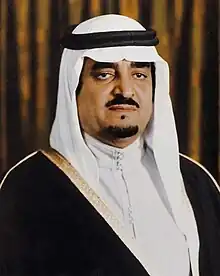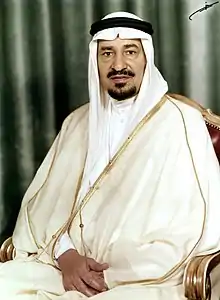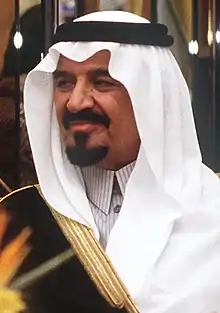| Prime Minister of Saudi Arabia | |
|---|---|
| رئيس وزراء المملكة العربية السعودية | |
 | |
| Incumbent | |
.jpg.webp) | |
| Mohammed bin Salman since 27 September 2022 | |
| Details | |
| Style | Custodian of the Two Holy Mosques (Formal) Your Majesty (Diplomatic) |
| Formation | 23 September 1932 |
| Residence | Al-Yamamah Palace (Riyadh) Al-Salam Palace (Jeddah) |
.svg.png.webp) |
|---|
|
|
| Basic Law |
|
|
The Prime Minister of Saudi Arabia (Arabic: رئيس مجلس الوزراء, romanized: raʾīs majlis al-wuzaraʾ) is the chairman of the Council of Ministers and head of government of the Kingdom of Saudi Arabia. The Prime Minister is always either the King of Saudi Arabia or Crown Prince of Saudi Arabia. Prince Mohammed bin Salman has been Prime Minister since 27 September 2022.[1]
History
The office was created along with the Council of Ministers on 9 October 1953, by decree of King Saud. Due to unrest within the royal family over his rule, Saud was forced to appoint his half-brother, Crown Prince Faisal, as prime minister. An ongoing power struggle between the two led to Faisal's resignation in 1960, allowing Saud to reclaim the reins of government, but continued discontent saw Faisal return as prime minister in 1962. After the deposition of Saud in 1964, Faisal succeeded him as king, while remaining prime minister. From that point until the appointment of Mohammed bin Salman as prime minister by King Salman, the two offices were merged.[2] Since the reign of King Khalid, others have done much of the "heavy lifting" as the king was either unwilling or unable to carry the workload, especially as the kingdom became a gerontocracy during the 1990s and 2000s. Royal favorites achieved power to become de facto prime ministers. The current one is the King's son Mohammad, who is his father's top aide.
List of Prime Ministers of Saudi Arabia
| No. | Portrait | Name (Birth–Death) |
Time in office | Notes | ||
|---|---|---|---|---|---|---|
| Took office | Left office | Days in office | ||||
| 1 |  |
Saud (1902 – 1969) King 1953 – 1964 | 9 October 1953 | 16 August 1954[3] | 311 | King Saud created the post of Prime Minister for himself, and appointed Crown Prince Faisal Prime Minister in 1954. The two would engage in a power struggle which would ultimately lead to Saud's abdication of the throne and exile. |
| 2 |  |
Faisal (1906 – 1975) | 16 August 1954 | 21 December 1960 | 2319 | First Crown Prince to serve as Prime Minister . |
| 1 |  |
Saud (1902 – 1969) King 1953 – 1964 | 21 December 1960 | 31 October 1962 | 679 | Second tenure. King Saud lost a power struggle to Crown Prince Faisal and was forced to abdicate in 1964. |
| 2 |  |
Faisal (1906 – 1975) King 1964 – 1975 | 31 October 1962 | 25 March 1975 | 4528 | Second tenure. Crown Prince Faisal became King on 2 November 1964 and was assassinated on 25 March 1975. |
| 3 |  |
Fahd (1920, 1921 or 1923 – 2005) King 1982 – 2005 | 25 March 1975 | 21 February 1996 | 7638 | Crown Prince Fahd became de facto Prime Minister during Khalid's reign (1975–1982) and through his own until suffering a stroke in 1996. Second Prime Minister who was not the King at the time of his appointment. |
| 4 |  |
Abdullah (1924 – 2015) King 2005 – 2015 | 21 February 1996 | 23 January 2015 | 6911 | Crown Prince Abdullah served as de facto Prime Minister after Fahd's stroke in 1996, de jure from 9 October 2005 to 23 January 2015. Some regard Khaled al-Tuwaijri as a de facto Prime Minister from 9 October 2005 to 23 January 2015. |
| 5 | _(cropped).jpg.webp) |
Salman (born 1935) King 2015 – | 23 January 2015 | 27 September 2022 | 2742 | Most day-to-day governance was handled by the King's son Mohammed bin Salman. |
| 6 |  |
Mohammed bin Salman (born 1985) | 27 September 2022 | Incumbent | 473 | Crown Prince since 2017. Chief of the Royal Court, Minister of Defense 2015-2022 for his father King Salman. |
First Deputy Prime Ministers of Saudi Arabia (1962–2022)
From 1965 to 2022, the Crown Prince was also First Deputy Prime Minister.
| Name | Lifespan | Reign start | Reign end | Notes | Family | Image |
|---|---|---|---|---|---|---|
Khalid bin Abdulaziz
| 13 February 1913 – 13 June 1982 (aged 69) | 31 October 1962 | 25 March 1975 (became king) | Son of Ibn Saud and Al Jawhara bint Musaed bin Jiluwi | Saud |  |
Fahd bin Abdulaziz
| 16 March 1921 – 1 August 2005 (aged 84) | 25 March 1975 | 13 June 1982 (became king) | Son of Ibn Saud and Hassa bint Ahmed Al Sudairi | Saud |  |
Abdullah bin Abdulaziz
| 1 August 1924 – 22 January 2015 (aged 90) | 13 June 1982 | 1 August 2005 (became king) | Son of Ibn Saud and Fahda bint Asi Al Shuraim | Saud |  |
Sultan bin Abdulaziz
| 1 August 1931 – 22 October 2011 (aged 80) | 1 August 2005 | 22 October 2011 (died in office) | Son of Ibn Saud and Hassa bint Ahmed Al Sudairi | Saud |  |
Nayef bin Abdulaziz
| 23 August 1934 – 16 June 2012 (aged 77) | 22 October 2011 | 16 June 2012 (died in office) | Son of Ibn Saud and Hassa bint Ahmed Al Sudairi | Saud |  |
Salman bin Abdulaziz
| 31 December 1935 | 16 June 2012 | 23 January 2015 (became king) | Son of Ibn Saud and Hassa bint Ahmed Al Sudairi | Saud |  |
Muqrin bin Abdulaziz
| 15 September 1945 | 23 January 2015 | 29 April 2015 (resigned) | Son of Ibn Saud and Baraka Al Yamaniyah | Saud |  |
Muhammad bin Nayef
| 30 August 1959 | 29 April 2015 | 21 June 2017 (deposed) | Son of Prince Nayef bin Abdulaziz and Al Jawhara bint Abdulaziz bin Musaed bin Jiluwi Al Saud | Saud | .jpg.webp) |
Mohammed bin Salman
| 31 August 1985 | 21 June 2017 | 27 September 2022 (became prime minister) | Son of King Salman and Fahda bint Falah bin Sultan Al Hithalayn Al Ajmi | Saud | _(cropped).jpg.webp) |
History of the second deputy prime minister position
The honorific title of "Second Deputy Prime Minister" goes back to 1967, in order to designate who was the senior prince not excluded from the throne. The position was created by King Faisal.
In March 1965, under pressure from King Faisal and the House of Saud, crown prince Mohammed stepped down as apparent to the Saudi throne. Mohammed was known to have temper issues and drinking problems.[4][5][6] As a result, King Faisal installed Prince Khalid as crown prince. However, he was reluctant to accept the offer of King Faisal to be named crown prince several times until March 1965. In addition, Khalid asked King Faisal to remove him from the position various times. One of the speculations about Prince Khalid's selection as heir designate was his lack of predilection for politics. In short, by selecting him as heir designate the royal family could create an intra-familial consensus.[7] In 1967, crown prince Khalid expressed his desire not to preside over the Council of Ministers against King Faisal's request which led to the appointment of Prince Fahd as second deputy prime minister with the task of leading the Council meetings.[8] Prince Saad and Prince Nasir, who were older than Fahd, were set aside from the throne due to being less experienced.[9]
When King Faisal was assassinated in 1975, King Khalid designated Prince Fahd as crown prince and Prince Abdullah as second deputy prime minister.
As King Khalid became ill with old age, the question of who would succeed Abdullah as the second deputy prime minister became more pressing. Prince Abdullah was succeeded by Prince Sultan as de facto Deputy Prime Ministers of The Kingdom.
Second Deputy Prime Ministers of Saudi Arabia (1967–2017)
| Name | Lifespan | Reign start | Reign end | Notes | Family | Image |
|---|---|---|---|---|---|---|
Fahd bin Abdulaziz
| 16 March 1921 – 1 August 2005 (aged 84) | 1967 | 25 March 1975 (became crown prince) | Son of Ibn Saud and Hassa bint Ahmed Al Sudairi | Saud |  |
Abdullah bin Abdulaziz
| 1 August 1924 – 22 January 2015 (aged 90) | 25 March 1975 | 13 June 1982 (became crown prince) | Son of Ibn Saud and Fahda bint Asi Al Shuraim | Saud |  |
Sultan bin Abdulaziz
| 1 August 1931 – 22 October 2011 (aged 80) | 13 June 1982 | 1 August 2005 (became crown prince) | Son of Ibn Saud and Hassa bint Ahmed Al Sudairi | Saud |  |
Nayef bin Abdulaziz
| 23 August 1934 – 16 June 2012 (aged 77) | 1 August 2005 | 22 October 2011 (became crown prince) | Son of Ibn Saud and Hassa bint Ahmed Al Sudairi | Saud |  |
Muqrin bin Abdulaziz
| 15 September 1945 | 27 March 2014 | 23 January 2015 (became crown prince) | Son of Ibn Saud and Baraka Al Yamaniyah | Al Saud |  |
Muhammad bin Nayef
| 30 August 1959 | 23 January 2015 | 29 April 2015 (became crown prince) | Son of Prince Nayef bin Abdulaziz and Al Jawhara bint Abdulaziz bin Musaed bin Jiluwi Al Saud | Al Saud |  |
Mohammed bin Salman
| 31 August 1985 | 29 April 2015 | 21 June 2017 (became crown prince) | Son of King Salman and Fahda bint Falah bin Sultan Al Hithalayn Al Ajmi | Al Saud |  |
See also
References
- ↑ "Saudi Arabia's Crown Prince to become Kingdom's Prime Minister: Royal decree". Al Arabiya English. Retrieved 2022-09-27.
- ↑ أرشيف-شاهد على العصر-الأمير طلال بن عبد العزيز ج1 [Watch the Times – Prince Talal bin Abdul Aziz] (in Arabic). Al Jazeera. 31 July 2016. Archived from the original on 2021-12-21 – via YouTube.
- ↑
- "Saudi Arabia". WorldStatesman. Ben Cahoon. Retrieved 2014-03-31.
- ↑ Ayman Al Yassini (August 1982). The Relationship between Religion and State in the Kingdom of Saudi Arabia (PhD thesis). McGill University. Retrieved 21 March 2021.
- ↑ Jafar Al Bakl (16 December 2014). "الفحولة وآل سعود... والشرف المراق على جوانبه الدم". Al Akhbar (in Arabic). Retrieved 12 September 2020.
- ↑ Donald S. Inbody (1984). "Saudi Arabia and the United States: Perception and Gulf security". Monterey, California: Naval Postgraduate School. p. 23. Retrieved 30 March 2021.
- ↑ M. Ehsan Ahrari (1999). "Political succession in Saudi Arabia". Comparative Strategy. 18 (1): 13–29. doi:10.1080/01495939908403160.
- ↑ "Saudi Arabia" (PDF). Association for Diplomatic Studies and Training. p. 77. Archived from the original (Country Readers Series) on 9 January 2021. Retrieved 7 January 2021.
- ↑ Simon Henderson (1994). "After King Fahd" (PDF). Washington Institute. Archived from the original (Policy Paper) on 17 May 2013. Retrieved 2 February 2013.

